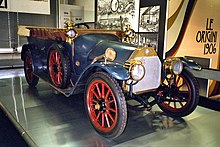Torpedo (automotive type)



The torpedo is a type of automobile (body shape) that was manufactured from the beginning of the 20th century to the mid- 1930s , but which disappeared completely before the Second World War .
history
The name Torpedo was introduced in 1908 by the Belgian car dealer Captain Theo Masui , who acted as an importer of the French car brand Grégoire in London and designed a streamlined body with the name The Torpedo .
This was developed a little later to its final form by adapting the shape of the hood to the belt line of the car, creating a continuous sideline from front to back. The progress compared to the Phaeton consisted in increasing the sideline and thus improving the safety for the occupants, especially when cornering. Torpedo thus became a generic name.
A “torpedo” usually has four or five seats and an open design with a relatively simple fabric roof that can be opened and low side panels and doors, but without B-pillars . Only the rear bows and the A-pillars support the roof. A decisive disadvantage of the torpedo body was the largely poor weather protection of the simple hood.
Automobiles with torpedo bodies were made by various manufacturers such as Fiat , Isotta Fraschini , Lancia and Rolls-Royce . Similar car types are the Phaeton and the Baquet. These forms became more and more similar over time and the name Phaeton finally caught on. However, due to more modern body designs, their importance had been on the decline since the 1920s and since then has been on the decline until it completely disappeared before the Second World War .
Deviations
Some automobile manufacturers and bodybuilders also used the term torpedo for other models, often for open versions with a sporty twist. Early examples of this are the Hupmobile Model 20 Torpedo, which was only offered in 1911 , actually a two-seater roadster with an egg-shaped rear, and Model T Torpedo Runabout , which, compared to other T models of this year, has a longer bonnet, rounder fenders and a lower seat position with the resulting longer steering column attached at a shallower angle. While the Hupmobile Torpedo had already disappeared the following year, Ford launched a Model T Torpedo Roadster in 1912 , which, however, no longer differed that much from the other models. The Citroën Model C, which was built from 1922 to 1926 and offered in two wheelbases (C2 and C3), became very popular in France. From both there was a version Torpédo with pointed tail ( "duck tail"), the C3 was behind also because the third seating position Trèfle called
Other uses
In the English-speaking world , starting from Great Britain, a truck with a hood ( hood handlebar ) is still sometimes referred to as a torpedo. In Italy , a rather simple off-road vehicle with a fabric or tarpaulin top is called a torpedo based on the torpedo bodies of the past . The body part between the windshield and the hood is called torpedo sheet or cowl .
Trivia
In German, English and Italian usage, torpedo refers to an underwater weapon with its own propulsion system and an explosive charge. It can be assumed that the name of the body shape goes back to this. In French, this naval weapon is called a torpille .
See also
literature
- Jean Henri-Labourdette: Un siècle de carrosserie française. Edita, Lausanne 1972, OCLC 889251702 .
- Beverly Rae Kimes (editor) and Henry Austin Clark, jr .: The Standard Catalog of American Cars 1805–1942. Krause Publications, Iola WI 1985, ISBN 0-87341-111-0 .
Web links
- Antique, Vintage an Classic Car Terms and Definitions at antiquecar.com (English)
- Antonio Amadelli: La mitica torpedo. (PDF, 101 kB) Museo Nazionale dell'Automobile , accessed on January 4, 2019 (Italian).
- Grégoire, Torpedo, 1910. In: When cars learned to run. Pantheon Basel , accessed on January 4, 2019 .
Individual evidence
- ↑ Jonathan Wood: Coachbuilding - The Hand Crafted Car Body. Shire Publications, Oxford 2008, ISBN 978-0-7478-0688-2 .
- ^ Antique, Vintage an Classic Car Terms and Definitions , Antiquecar.com
- ^ BR Kimes (ed.): Standard Catalog of American Cars 1805-1942. 1985, p. 721.
- ^ BR Kimes (ed.): Standard Catalog of American Cars 1805-1942. 1985, p. 552.
- ^ BR Kimes (ed.): Standard Catalog of American Cars 1805-1942. 1985, p. 553.
- ↑ shamrock
